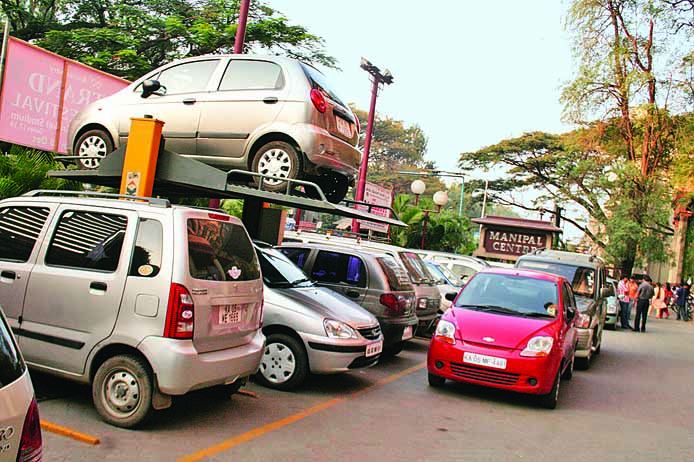http://www.dnaindia.com/india/report-a-recipe-for-decongesting-mumbai-and-delhi-2041737
http://www.dnaindia.com/india/report-a-recipe-for-decongesting-mumbai-and-delhi-2041737
A simple way to solve illegal parking and hawking and also de-congest India’s cities
Multi-storey parking lots can address the needs of investors, municipal and private vehicles, hawkers, kiosks and eateries
Mumbai is getting clogged. Its pavements have been usurped in many places by hawkers, hutments and stalls. At least two lanes on any road are usurped by parked vehicles, often abetted by municipal garbage bins and vans.
dna’s own estimates show that revenues lost through such illegally occupied spaces could be at least Rs20 crore in cash every day. Anecdotal reports indicate that some of this money is invariably shared by municipality officers, police and locally elected corporators.
Mumbai has around 20 lakh vehicles plying its roads. But it has less than 150 legal parking lots. Together they give Mumbai a parking place ratio of one parking spot for every 120 vehicles.
 Delhi presents an equally dismal picture. It has around 25 lakh cars and just around 32,000 legal four-wheeler parking spots. That means only one parking spot for every 78 cars. But, mercifully, Delhi has more unclogged pavements.
Delhi presents an equally dismal picture. It has around 25 lakh cars and just around 32,000 legal four-wheeler parking spots. That means only one parking spot for every 78 cars. But, mercifully, Delhi has more unclogged pavements.
The solution could lie in just providing for multi-storey car-parks-cum-community-centres.
The economics
Any civil engineer will tell you that bare construction – pillars, slabs and elevators – should not cost more than Rs1,000 per square foot.
A car requires around 50 square feet for being parked. Add to this another 50 square feet, including manoeuvering space, common passages and ramps. That comes to an average of 100 sq ft per car.
A minimum 15% rate of return on capital investment demands a return of at least Rs15,000/year/car parking slot; or Rs50 a day.
The minimum parking rate in Mumbai is Rs20/hour – in some places it is Rs50-100/hour. If the developer gets an occupancy level of four hours a day, he would generate decent profits even after meeting operational costs (guards, cleaners, electricity and maintenance of elevators, closed circuit cameras etc). With many cars requiring parking space for the whole day or even the whole night (in residential areas) the returns are bound to be incredibly high.
dna’s calculations show that the average car park would get a rate of return of not less than Rs4 per square foot per day (Rs400 per parking slot), or an 800% rate of return on capital invested.
Greater relevance
There are other sources of income as well, which generate both profits and relevance.
A multi-storey parking lot could have the ground floor reserved for taxis, autorickshaws and emergency vehicles – ambulances, police and municipal vans. And for toilets.
If the government wants, the toilets could be connected to a methanation chamber (http://www.dnaindia.com/analysis/column-policy-watch-oh-shit-a-rs-150617-crore-business-2033671). The gas could be stored for cooking purposes on the roof of the building, thus posing no hazard to the floors below.
If required the developer could invite ATM centres to be set up on this floor.
The first floor (or the first two floors) could be reserved for hawkers peddling their wares. Ever since the Lok Sabha passed the Street Vendors Bill in September 2013, even the courts agree that at least 2.5% of a city’s population should comprise vendors. That would reduce the premium caused by space shortages, and make shopping convenient for people, including car-owners.
One or two floors could be reserved for food courts and eateries.
The car parks could be kept on the floors above. Each multi-level car park ought to dedicate at least 10 floors for parking vehicles. At trucking sites, the parking bays, and the parking fees, are bound to be higher, and the nature of hawking spots suitably modified.
The top two floors could be reserved for social events like marriages, parties and celebrations. That would be convenient for car and taxi users.
Plus, there is money to be earned from display and advertising spots in and around the building.
Caveats
Such a facility could help the city only if three conditions are imposed very rigorously.
First, zero-tolerance for any hawkers, stalls or obstruction on pavements. Ditto for any cars, motorcycles, scooters, rickshaws (motorised and otherwise) or even handcarts parked on roads. Unless this is done, you cannot decongest the city. Instead you will create opportunities for officials to grease their dirty palms for allowing people to park their vehicles outside their shops/residences.
Second, such multi-level parking-cum-utility centres should exist at distances not more than 500 metres apart from each other. This will ensure that no person has to walk more than 250 metres to reach a toilet, hawker, food-court or a parking place.
Third, since these would be public access areas, the state must grant such developers an FSI of 4 or more which would allow such plots to have structures of 15 floors or more.
That will decongest the city’s roads and pavements, make the streets more navigable, get the city more money, and leave the pavements for pedestrians, especially children and the elderly.
Suggested modus operandi:
All the parking lots could be given to developers on the basis of auctions. The winner would be the developer who offers the highest share of revenues to the government/municipality. The rental rates for all categories should be pre-determined, indexed on the Income Tax prescribed rateable value of properties.
Auctions should be separately held for plots already owned by developers (who could offer a smaller share) and plots provided by the government. And since ad display rates are subjective, they may be excluded from the purview of revenue share.
Advantages:
- The shortage of parking spaces will suddenly disappear.
- A proper accounting system automatically gets kicked into place.
- Everybody benefits – hawkers, pedestrians, residents, vehicle owners and drivers, stall owners etc.
- The only losers will be racketeers and beneficiaries of ill-gotten gains.
- Such a scheme can be implemented overnight. It is profitable, both for the government and for the investor.
Caution:
There is a good chance that the scheme will not get approved because it would take away ill-gotten gains. Unless, of course, the courts intervene and compel the government to consider its implementation or provide cogent reasons for not doing so.





































COMMENTS